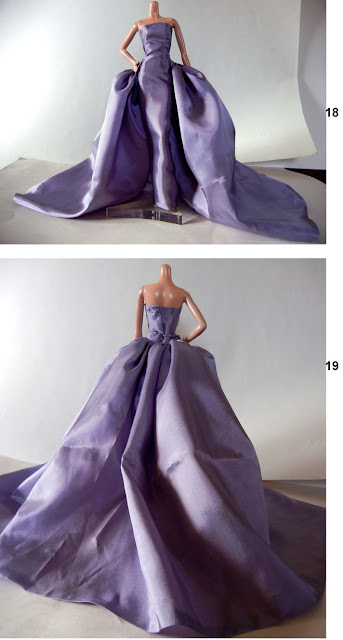Long before "social distancing" became a universal thing, there were dresses that forced people to stand, walk or dance several feet apart. Those dresses had structures beneath them called bustles which were made from wire, boning, crinoline and even pads and petticoats to help maintain their shape. And though silhouettes were greatly simplified and brought close to the body after World War I, some form of those wide garments have somehow survived. It lives on in the form of wedding dresses, debutante ball gowns, prom frocks and especially red carpet formal wear. Though many of us remain confined in our homes with nowhere to do, there's no reason our dolls can't get all dressed up like the princesses they are and head to an imaginary ball.
Before we get started, I would like to explain... the technique in this tutorial is the way I create bustle dresses. It may or may not have anything to do with the manner in which its full scaled version. I would also like to point out that there is a difference between fashion and period costume. While the modern ballgown may flirt with the voluminous proportions of its 19th century ancestor, for these dresses to be considered fashion, they must respect modern proportions and aesthetics. In this case, it means softening things up so that the dress flows and is less rigid.
For this project, you will need a simple, evening length dress and a rectangle of matching or contrasting fabric. Depending on how full you want your silhouette will determine the width of your fabric. For this (Barbie) dress, the width of my fabric is 42" (106 cm). Same thing with the length. Though I chose a strapless sheath for this tutorial, your dress can be anything you want. It can have a full bodice, or sleeves. It can be slim or flared. What I like to do is build the bustle as a separate entity that can be pinned temporarily over the existing garment or stitched down permanently. I construct it like this as opposed to creating a single pattern with the volume worked in because this method allows me to better control the look and fit simply and quickly.
1. My dress begins with a simple strapless, sheath dress.
2. After determining the length and amount of fullness, I cut a rectangle of matching or contrasting fabric. Turn under the side edges as well as the hem. The top edge is gathered with a running stitch.
3. Draw the stitch into gathers so they fit from side to side across the back.
4. It's like a half-gathered "train" that only extends only across the back of the dress. Pin and adjust. Then remove and secure the gathers with another stitch so they don't move.
5. Next, create your own "bias tape" by cutting a strip of fabric diagonally on the fabric that measures a little more than the circumference of the doll's waist by 1" (2.5cm) tall. Note: This strip really have to be cut on the bias so that it curves around the waist smoothly!
6. Fold one side and the bottom edge under and press.
7. Pin the folded over the gathered edge of the "skirt," pin then stitch in place.
8. Fold the top edge down but just until it reaches the top edge of the gathered train Press but don't stitch it down yet.
Though I have a lot of fabric in this train already (42") it will need something to help the gathers maintain their fullness and not droop. You will need some sort of "padding."
13. Apply to the middle back of the gathered train.
14. Stitch the top folded edge of the train to the top edge of the ribbon on the padding. This is just to keep the padding from shifting.
15. Fold each side of the train inwards towards the center.
16. Pen both edges of the waistband together.
17. Stitch shut along the top and the bottom of the "waistband.". The end result will look like a gathered skirt where the waistline has been sewn shut.
18-19. Place over the train over the dress and make any needed adjustments needed on the front or back. Pin in place. I add some sort of embellishments to the train so that it comes together as a complete look. We will need to figure out how our doll gets in and out of the dress! At this point, you can decide whether you want this train to be permanent or simply pinned on. For this dress, I have decided to make the train a permanent part of the dress. It will be stitched onto half the back (to the opening) then attached to the other side with a hook and eye.
B. Allow the medallions to extend over the side of the tape so that it will overlap and blend into the rest of the dress. When you have completed this, pin the dress to the dress for placement. Then stitch the train from the front of one side across the back to the center back closure. The doll must be able to get out of the dress, so I secure it only as far as the back opening. The remainder of the "waistband" will lay over the other back half of the doll's body then attach to the side front with hook and eye as explained in the next two steps.
C. Add a hook to the underside of the lace medallion.
D. Add the "eye" (in this case I made a crochet eye instead of the metal one) to the front of the dress where the medallion will attach to the dress.
21. When you are finished, it will look something like this from front to back
22. You can use almost anything for the embellishment like lace or tiny silk flowers!
You don't have to use a slim dress. You could start out with something more flared. And something more decorative!
This is a princess lined, "faux embroidered" dress we made awhile ago. Notice it has an A-line silhouette. But what if we wanted something rounder, fuller....
I used the same technique as the first dress. Instead of the dryer sheets, I gathered a width of tulle which is about 2" (5cm) deep. It is applied exactly as we did to the train in the first dress. Instead of beads, I cut a bit of lace from an old shirt to add to the top of my train.
From the front, the difference appears to be more discreet but once you turn her a bit to the side and the back, you notice how much rounder the silhouette appears. For me, this will be temporary, which will give me the option of having two looks.
This was a red carpet dress worn at the Golden Globes last year. It was a red silk strapless sheath dress with two small peplums on either side of the front.
There are a couple of things happening here. First I created a train, using the above technique for the first dress. The top of it is placed just under the peplum at the side and wraps across the back to the other side, then tacked under the opposite peplum.
Instead of adding the gathered tulle for padding, I took a length of chiffon and gathered it into a soft knot which was then added on top of the train.
Each layer is longer than the other to create this most elegant silhouette.
Finally, this is the (Versace) gown Lady Gaga wore to the 2019 Golden Globes Award show. I was most intrigued by its "Marie Antoinette" allure. I did not have the time to make another, so I'll walk you through the steps I made to create this look. There are several things going on here. The dress is a strapless, princess line gown with a long (incorporated) train in the back. See "Train of Thought" for the instruction. The sleeves are separate puff sleeves. The ribbons that wrap around her wrists are separate as wel.
To this dress I added little poufs created from the same fabric as the dress. Again, they are made by creating folding bits of fabric and gathering them into small pouches. I applied these to the sides and the back of the dress.
The result is most regal!
Like us on Facebook: @FashDollStylist
.
De: Fashion Doll Stylist - https://fashiondollstylist.blogspot.com/2020/05/la-vie-en-chateau.html
Fecha: May 06, 2020 at 12:59PM
.
Haz clic en la imagen de abajo para ver otro de mis Blogs.
Encontraras mas publicaciones interesantes.
































0 comentarios:
Publicar un comentario